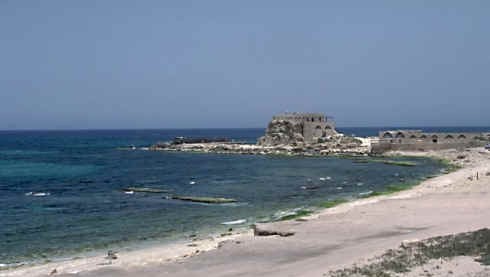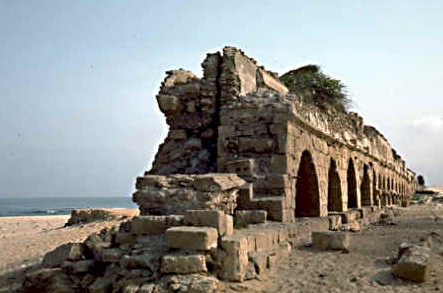Latin: "Caesar's city
on the sea"
The largest city in
Roman Palestine was a totally new foundation built by Herod
at the site of a Greek military encampment on the Mediterranean
coast of Samaria
that had been previously known as Strato's Tower. Though Alexander
Jannai occupied the area
as early as 96
BCE, there was no Israelite settlement at the
site before Herod began construction (ca. 20
BCE) of an 8000
acre seaport that rivaled Alexandria & Antioch in
commercial importance. The 40 acre harbor was bigger than that
at Athens. It was one of the most ambitious construction
projects in Near Eastern history.
Caesarea was designed as a
model Roman city, complete with aqueducts, sewers, a forum,
mosaic walkways covered with marble colonnades, a racetrack
[hippodrome], an amphitheater (larger than the Coliseum in
Rome) & a large temple dedicated to Augustus
& Roma. It was Herod's tribute to his Roman patrons. After
Herod's son Archelaus
was deposed, it became the Roman capital of Judea
& Samaria. A stone with a dedication by Pontius
Pilate found in the
theatre provides physical evidence that it was the primary base
of the Roman prefects. Josephus reports that Herod's grandson Agrippa
died shortly after his triumphal appearance in the theater at
Caesarea. The book of Acts claims that several early Christian
missionaries [Philip, Peter & Paul] visited the city in the
decades after Jesus' crucifixion. Luke also reports (Acts 23-25)
that Paul was held at the Praetorium [headquarters of
the imperial forces] at Caesarea for several months in 60-61
CE.
Five years later the Jewish revolt against Rome began at
Caesarea with riots between gentiles & Jews. In the 3rd
& 4th c.
CE Caesarea became a major center of Christian
learning due to the theologian & biblical exegete Origen
& the historian Eusebius.
References: Josephus,
Antiquities
15.293, 339; 16.13; 19:343-365.
_____, War 1.80;
2.16-17, 282-296, 457-459.
Acts 8:40, 10:1-11:18, 21:8-16; 23:23-35; 25:1-32.


![]()

![]()
![]()
![]() Perspective on the
World of Jesus
Perspective on the
World of Jesus ![]()